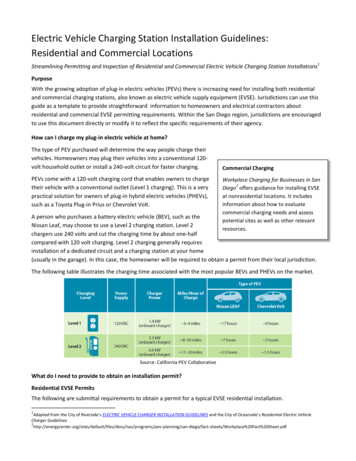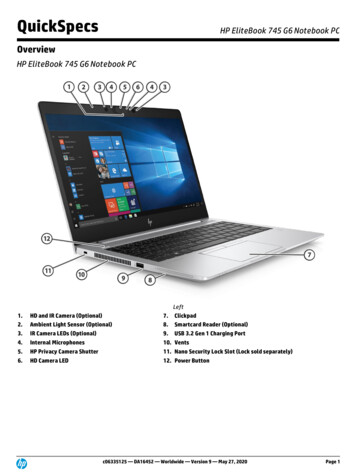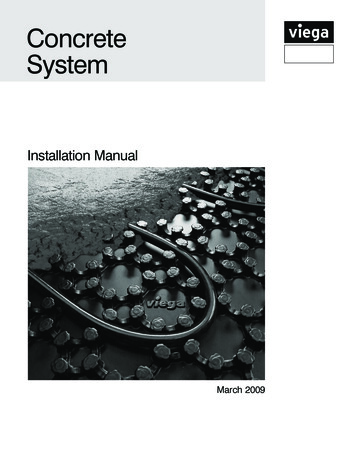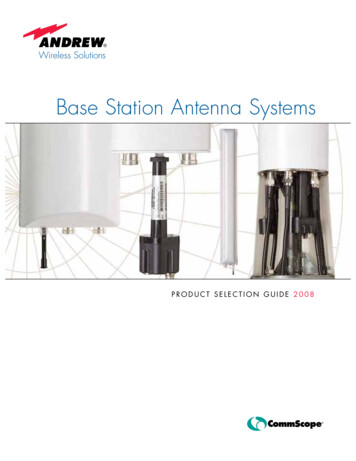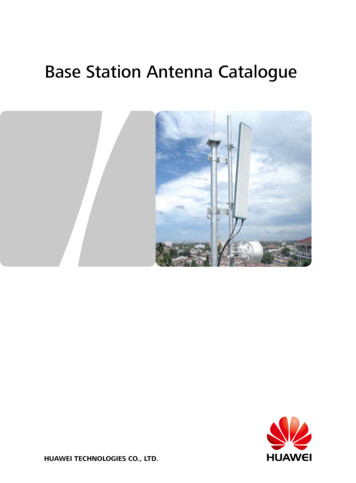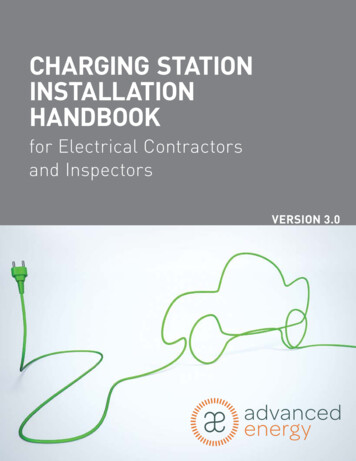
Transcription
Charging StationInstallationHandbookfor Electrical Contractorsand InspectorsVERSION 3.0 2013 2011 Advanced Energy1
Charging StationInstallation Handbookfor Electrical Contractors and InspectorsDISCLAIMERVersion 3.0May 2013This handbook was made possible through the supportof Duke Energy, the North Carolina Electric MembershipCorporation and Dominion North Carolina Power, as wellas the City of Raleigh, who supplied information and sharedbest practices regarding charging station installation.You understand and agree that the installation, operation, maintenance and inspection of electrical charging stations for electric vehicles is an extremely complex and dangerous activity.This charging station installation handbook (the “handbook”) is provided “as is.” Except as set forth herein, North Carolina Advanced Energy corporation (“Advanced Energy”) makes norepresentations or warranties of any kind with respect to the handbook or its use, express, implied or statutory, including, without limitation, any implied warranty of merchantability, orfitness for a particular purpose, and Advanced Energy hereby disclaims the same. Without limiting the generality of the foregoing, Advanced Energy makes no representation or warrantythat the handbook is without errors or that all information included in the handbook is true, accurate or correct. Your use of the handbook does not guaranty and results or performance.To the extent permitted by law, you acknowledge and agree that Advanced Energy shall not be liable for any direct, indirect, special, exemplary, consequential or incidental damagesarising out of or in connection with your use of the handbook (including, without limitation, any damages for business interruption), whether arising from mistakes, errors, omissions,interruptions or loss of profits, even if Advanced Energy has been advised of the possibility of such damages. Without in any way limiting the foregoing, if for any reason, by operation oflaw or otherwise, any portion of the foregoing limitation of liability shall be voided, then in such event, to the extent permitted by law, you accept that the maximum, sole, and exclusiveaggregate liability of Advanced Energy, its agents and employees hereunder, shall be limited to general money damages in an amount not to exceed the total amount actually paid toAdvanced Energy by you for the handbook.Use this charging installation handbook (the “handbook”) at your own risk. By using this handbook, you agree that you are solely responsible for all damages, injury or even death thatmay result from or be caused by such use. If you do not agree to be fully and solely responsible for your use of the handbook, do not use this handbook. You hereby expressly foreverYour Feedback Matters!release and discharge Advanced Energy and its successors, or assigns, as well as its officers, directors, employees, agents and consultants from all claims, demands, injuries, expenses,damages, actions or causes of action suffered or incurred by you related to or arising form your use of the handbook.With publication of Version 3.0 of the Charging Station Installation Handbook for Electrical Contractors andThis handbook is protected by the U.S. Copyright Act and international treaties, and any reproduction of all or any part of this handbook without the express written permission ofInspectors, Advanced Energy is currently seeking feedback on the information presented, methods used andAdvanced Energy is prohibited.best practices. This feedback will then be reviewed and incorporated into the next version of the handbook.To provide your feedback, please visit www.AdvancedEnergy.org/transportation/feedback.php North Carolina Advanced Energy Corporation 20132Charging Station Installation Handbook for Electrical Contractors and Inspectors Version 3.0 2013 Advanced Energy3
Driving the Futureof TransportationAdvanced Energy’s Electric Transportationsector is working to assist utilities,charging station vendors, municipalitiesConsulting& Planningand all initial stakeholders inunderstanding, planning and implementingelectric transportation initiatives. As yourtrusted resource for advancing electricTechnology& EvaluationPEV COMMUNITYPLANNING GUIDEBOOKCHARGING STATIONTECHNOLOGY REVIEWtransportation, we can assist you increating a strong foundation for successfulchange through:yyConsulting and PlanningyyTechnical EvaluationyyEducation and OutreachEducation& OutreachCHARGING STATIONINSTALLATION HANDBOOKThe future of transportation is here! As more and more consumers purchase plug-in electric vehicles (PEVs), the demand forelectrical charging stations will increase. As such, contractors will receive more requests to install charging stations – fromnew construction and existing homes to retail outlets, corporate campuses and parking decks. With this evolving technology,electrical inspectors will also be challenged as requests for approvals increase and the scope of installation varies.We’re here to help. Our handbook includes overviews, guidelines and checkliststo help contractors and inspectors deal with the influx of requests.4Charging Station Installation Handbook for Electrical Contractors and Inspectors Version 3.0 2013 Advanced Energy5
ContentsCharging Levels2DISCLAIMERWith the rollout/adoption of PEVs, there is a clear and present need for electric vehicle supply5Driving the Future of Transportationequipment (EVSE), most commonly referred to as charging stations. Charging stations are the7Charging Levels8Applicable Codes & StandardsLevel 1 & 2 stations, it is not a battery charger. Only DC Fast Chargers include an actual charger.20Installation LocationsThe main purpose of a charging station is to establish communication with the vehicle and to20Single-Family Housing20Multi-Family Housingpoint of power for electric vehicles, ranging in style and charging levels and subject to standardsand codes. It is important to note while an EVSE is normally referred to as a charging station, fortransfer power to the PEV while providing proper grounding, shock protection, overload protectionand general safety. The PEV will have an onboard battery management system and charger.21 Non-Residential22There are three levels of charging, offering a range in charge timeand infrastructure simplicity. For infrastructure planning purposes,charging stations are considered to be continuous loads.Installation Preparation23 step 1: Prep Work24 step 1: site information26 step 2: onsite evaluation27 step 2: charging station selectionCharging Level28 Surveying Charging Stations: Residential GarageFeaturesyy120 VAC, 15 or 20 A circuit based on the standard American home outletyyWill take the longest time – eight to 10 hour full charge*32 Surveying Charging Stations: Parking Decks and SpacesyySimplest; easily accessible for vehicle owners34 Surveying Charging Stations: Parking Lots and SpacesyyUses amount of power similar to a hair dryer or microwaveyySuited for low-speed NEVs and some PEVs with short electric-only range; may also be wellsuited for locations where a PEV will be parked for extended periods (days/weeks)yy208/240 VAC, 80 A maximum current (100 A circuit)39 step 3: Installation PreparationyyWill use only the SAE J1772 specified plug41yyUses amount of power similar to large appliances, such as air conditioners or clothes dryersyyRequires two to three hour full charge*yy480 VDC / 100 A (and up) fast chargeyy80% charge in around 30 minutes*30 Surveying Charging Stations: Residential carport/drivewayLevel 136 Surveying Charging Stations: On-street parking & Spaces38Step 3: Installation InspectionLevel 2FULL Process Checklist42 Glossary43Appendix A: Special Installation Case: Historical Homes44Appendix B: Encroachment agreements46Appendix C: NEMA Enclosure Type*Estimated charge time based on a vehicle utilizing 40 miles of electric-only driving between charges.48 Ramp up your knowledge50DC Fast ChargeWhy Advanced Energy?Level 2 charging is likely to be the most common form of vehicle charging in the foreseeablefuture. The majority of this document refers to the installation of Level 2 conductive chargingstations.6Charging Station Installation Handbook for Electrical Contractors and Inspectors Version 3.0 2013 Advanced Energy7
Applicable Codes & StandardsSociety of Automotive Engineers andNational Electrical Code StandardsIn order to ensure common standards for vehicle charging, the Societyof Automotive Engineers (SAE) has developed standards for energytransfer and a common cord set. These standards will ensure allPEVs have a common charging ‘plug,’ meaning any PEV will be ableto plug into any charging station. The two main standards are SAEJ1772 and SAE J2293, which reference other SAE, National ElectricalCode (NEC) and Underwriters Laboratories (UL) standards or codes.UL StandardsNEC STANDARDS for Charging StationsStandardDescriptionNEC 110.11Deteriorating AgentsNEC 110.28Enclosure TypesNEC 110.26Electrical Equipment SpacingNEC 110.26 (A)(2)Width of Working SpaceNEC 110.27(B)Guarding of Live Parts – PreventPhysical DamageNEC 210.70(A)(2)Lighting Outlets Required –Dwelling Units – AdditionalLocationsSAE Standards for Charging StationsStandardDescriptionJ1772Electrical and mechanical aspectsof the cord set; references ULfor safety and shock protection aswell as the NEC for the cordand coupleJ2293Standard for the electric vehicleenergy transfer system. This systemNEC 300.4Protection [of conductors]Against Physical DamageNEC 334.15Exposed Work [requirements fornonmetallic-sheathed cable]NEC 334.30Securing and supportingnonmetallic-sheathed cableNEC 625.1 – 625.5General (Scope, Definitions, OtherArticles, Voltage, Listed/Labeled)NEC 625.9 (A-F)Wiring Methods(Electric Vehicle Coupler)encompasses what goes from thecharging station to the car.J2293-1safety standards for charging electric vehicles. There are five primary standards:UL STANDARDS for Charging StationsStandardDescriptionUL 62Standard for flexible cords and cables required by NEC 625UL 2202Charging station design and constructionUL 2231Charging station shock prevention measures define proper grounding and ground fault interruptionUL 2251Cord design and safety covers the plug, cord, receptacle, connectors and other items related to the chargingcord set. Also verifies the cord’s safety and ability to carry its rated load.UL Subject 2594Charging station safety covers off-board equipment that supplies power to a vehicle, including PEV poweroutlets, cord sets, or standalone charging stationFunctionality requirements andsystem architectureJ2293-2In conjunction with other PEV and charging station standards in development, UL is currently developingCommunication requirements andnetwork architectureNEC 625.13 – 625.19 Equipment ConstructionNEC 625.21 –Control and Protection625.26NEC 625.28 –625.308Electric Vehicle SupplyEquipment LocationsCharging Station Installation Handbook for Electrical Contractors and Inspectors Version 3.0 2013 Advanced Energy9
Applicable Codes & StandardsApplicable CodesThe codes and standards governing accessibility at a given facilitycan vary depending on which codes have been adopted by theapplicable state or local jurisdiction and by the type of facility.Title II facilities are state or local government facilities, and Title IIIyyThe American National Standards Institute’s (ANSI) Standard A117.1 “Accessible and Usable Buildings and Facilities;” andyyThe U.S. Department of Justice (DOJ) 2010 ADA Standards for Accessible Design.yyTitle II facilities must comply with the U.S. DOJ 2010 ADA11, which references the 2009 ANSI A117.1 Standard.On a given site the NC DOI views a contiguous group ofTitle III facilities must comply with the 2012 NC Building Code,Chapter 11, which references the 2009 ANSI A117.1 Standard.1 NC Department of Insurance Access Update Newsletter, Vol. 3 Issue 2, August 20122 Note that the ADA Standards may also be enforced by the US DOJ.3 The 2012 NC Building Code is the 2009 International Building Code with NC amendmentsAnticipating Code UpdatesConversations with North Carolina city and county officials, as well as with accessibility code consultants at the North Carolina Department ofwith regard to updates. Construction that pre-dates a buildingInsurance (NC DOI), which is responsible for interpretation of North Carolina’s building and related codes, have assisted in the developmentcode revision is typically “grandfathered” in complianceof the following guidelines. This is the best known guidance at this time for local officials and property owners who are preparing to installwith the code that was in effect at the time of construction.charging stations.Instead, as the accessibility code is updated, facilities arePublic and private entities intending to install charging stations for public use have one major challenge: governing codes and standards dogenerally required to upgrade to the current standard. ItSome generic accessibility requirements for public infrastructure or services are easily assessed (for example, reach ranges for operablecontrols). However, the most common type of public charging is currently provided by adding charging hardware to an existing parking space.In many cases these new charging spaces are restricted for use by PEV owners.As a result, the primary purpose of the space becomes fueling instead of parking. This can create confusion as to which accessibilityrequirements should apply and how they should be interpreted. While several requirements are simply undefined at this time, there are existingaccessibility requirements for parking facilities that can be used as a guide.The following sections outline the areas of disabled-accessibilityto be considered when installing a charging station.10Charging Station Installation Handbook for Electrical Contractors and Inspectors Version 3.0refers specifically to the EVSE.Number of Accessible Charging Stationsdoes not function in the same manner as most other codesnot yet specifically address PEV charging stations.to as “charging spaces,” and “charging hardware”Standards 2 AND the 2012 NC Building Code 3, ChapterSite owners must keep in mind that the accessibility codeADA Guidance in North Carolinathe NC DOI. Where available, specific code references are provided.For simplicity parking spaces served by EVSE are referredAs municipalities and businesses install publically available PEV charging stations, an important designThe International Building Code (IBC);local AHJ, which may be supported by a formal interpretation fromIn North Carolina, the local Authority Having Jurisdiction (AHJ)Governing Standardsyyvehicle charging station is subject to the code enforcement of theSite Designyyis mandated by the Americans with Disabilities Act (ADA) and is generally governed by three standards:provided as guidance only – official compliance for any electricfacilities are public accommodations and commercial facilities.is responsible for enforcement of the applicable requirements1:requirement is to ensure accessibility for disabled users. In the United States, the accessibility of public facilitiesThe requirements and recommendations described herein aremay be more cost effective to proactively provide chargingstation accessibility because doing so may reduce futurelegal liability, and future retrofits could cost significantlymore than enhanced construction in the present.Charging station installations may also begoverned by regulations found in a localzoning ordinance or unified developmentordinance. 2013 Advanced Energycharging spaces as a distinct parking facility, as describedin NC Building Code (NCBC) 1106.1. Although there are noexplicit requirements at this time for the number of chargingspaces that must be accessible, it is recommended tofollow the requirements for standard and van-accessibleparking spaces presented in NCBC Table 1106.1 and Section1106.5 (see Table 1).yyThe first charging space that is installed should be sized for vanaccessibility.yyA second accessible charging space is recommended when the26th charging space is installed, and that second accessibleTotal ChargingTotal AccessibleVan-AccessibleSpacesCharging SpacesCharging 61201-3007211
Applicable Codes & StandardsAccessible Sample Design #1: Installation in Parking Lots at Medians or Grade Perimetersaisle that is a minimum five feet wide. Alternately, the van-accessibleparking space may be eight feet wide if the adjacent access aisle isat least eight feet wide, but the standard 11 foot width is preferred toprovide more flexibility to the driver for positioning of the vehicle.Any standard (non-van) accessible stalls must be a minimum eightCharging StationCharging StationOptional Protective Bollardfeet wide with an adjacent access aisle that is at least five feet wide.In both cases, the minimum length of the parking spaces should be18 feet. Note that local ordinances may require a longer space.4’RAISED CURBAccessible RoutesWhile the primary purpose of a charging space is vehicle fueling, itis also reasonable to expect that drivers may want to use a particularcharging station due to its association with a specific building on asite. NCBC 1104.2 requires that at least one accessible route connectaccessible buildings and other accessible elements or spaces that areon the same site.While accessible parking spaces must be on the shortest accessibleroute to the associated building entrance, accessible chargingspaces may be on a longer route, because the primary purpose of thecharging space is vehicle PACE18’(Optionally SharedStandard 8’STANDARDPARKINGSPACE(Optionally SharedVan-AccessibleCharging Space)8’8’charging space should be sized as a standard (non-van) accessibleThere is an exception to NCBC 1106.1 for certain types of fleet vehiclespace. At least one space should be sized for van-accessibility outand motor pool parking facilities where lots accessed by the publicof every six accessible charging spaces that are present (1:6).are provided with an accessible passenger loading zone. AccessibleIn some designs, a facility owner may install charging hardware suchthat it can be shared by a standard charging space and an accessiblecharging space. Such installations may be interpreted as satisfyingthe requirement for accessible charging spaces.In multi-level parking structures, all charging spaces may be allowedto be located on one level. In parking facilities for buildings withCharging Station4’Charging Station5’Optional Protective BollardRAISED CURB2’WHEEL STOPSTANDARDCHARGINGSPACEpassenger loading zones are addressed in NCBC 1106.7 and ANSI503, where the basic requirements include a pull-up space that isa minimum eight feet wide by 20 feet long with an adjacent accessVAN- ACCESSIBLECHARGING SPACE18’STANDARDPARKINGSPACEaisle that is a minimum five feet wide by 20 feet long, marked so as todiscourage parking in the aisle.Layout of Accessible Charging Spacesmultiple accessible entrances, charging spaces are not required toLayout and dimensions of accessible parking spaces are definedbe dispersed. However, if charging spaces are provided in multiplein ANSI 502. Accessible charging spaces should follow the samelocations for buildings with multiple accessible entrances, thenguidelines, namely that the first charging space, sized for van-accessible charging spaces must be provided at each location.accessibility, be a minimum 11 feet wide with an adjacent access12AccessibleSampleDesign #2:Installationin ParkingLots atMediansor GradePerimetersCharging Station Installation Handbook for Electrical Contractors and Inspectors Version 3.08’ MINIMUM 2013 Advanced Energy5’11’8’ MINIMUM13
Applicable Codes & StandardsAccessible Sample Design #3: Installation in Parking Lots at Sidewalk BoundariesWhile any requirement for an accessible route from an accessiblecharging space to an associated building may be subject tointerpretation, it is clear that there must be an accessible route betweenthe charging space and the charging hardware. The goal: ensure thatonce a PEV is maneuvered into the space, the driver can connect theSIDEWALKRAMP SLOPE1:12 MAXIMUMcharging cord to the vehicle charging inlet. It is acceptable for the driver4’5’to place the charging cord in or along that accessible route for theCharging Stationduration of the charging process.However, charging stations should be positioned in such a mannerRAISED CURBthat their cords WILL NOT block any sidewalk or obstruct any other2’accessible route while the cord is connected to a vehicle. It is possiblethat designs may be required to prevent or restrict such an impediment,WHEEL STOPespecially if the accessible route (or access aisle, if applicable) serves aOptional Protective Bollardfunction or pathway beyond access to the charging hardware itself, e.g.STANDARDPARKINGSPACEVAN- ACCESSIBLECHARGING SPACE18’(Optionally Accessible)STANDARDPARKINGSPACEcomplementary access to a building entrance or to a public way.8’station owners may establish ordinances defining the legal use of publiccharging spaces as well as the potential penalties for improper use, andcommercial owners may define similar policies that are enforced at theirdiscretion.It is not recommended to mark accessible charging spaces for the use ofthat it can be shared between a marked-accessible parking space andonly disabled-marked vehicles because:marked-accessible parking space, or to install charging hardware suchanother charging space. In such cases, the primary purpose of theyyThe primary purpose of charging spaces is vehicle fueling; andyyThe installation of accessible charging spaces does not reduce theSuch installations may be interpreted as satisfying the requirement fornumber of required accessible parking spaces at the same site.accessible charging spaces. In such cases, the NC DOI recommendsbut not limited to, use by disabled patrons. Charging station owners11’charging spaces to specific types of vehicles (e.g. PEVs only). MunicipalFinally, a site owner may choose to install charging hardware at agoverned by NCBC 1107.6, where accommodation is available for,5’Charging station owners may or may not choose to restrict the use ofAvailability for UseThis model is similar to the provision of accessible hotel rooms8’Charging station owners may chooseto install signage that indicates“accessible priority” at accessiblecharging spaces, guiding non-disabledusers to park in any available standardcharging space before using anaccessible charging space.marked space would remain the parking of disabled-marked vehicles.that signage be provided to clarify that charging is not required in orderto use the space. For example, “Accessible Parking. EV Charging is anAccessory Use” Or “EV Charging Optional.”may choose to install signage that indicates “accessible priority” ataccessible charging spaces, guiding non-disabled users to park in anyavailable standard charging space before using an accessible chargingNote that NCBC 1104 requires an accessible route to be a fixed, firm,The addition of charging spaces to an existing parking facility willspace. Should the owner decide to mark accessible charging stalls fornon-slip path of travel that is a minimum 48” wide, which exceedsgenerally be interpreted as new construction, not an alteration. As athe use of disabled-marked vehicles only, NCBC 1110 and ANSI 502.7the requirement in ANSI 403.5 for a 36” minimum width. Other keyresult, exceptions to the requirement for an accessible route due todefine the related requirements.requirements for accessible routes include:disproportionality of costs are unlikely to be available unless they resultyyyy14A maximum running slope of 1:20 and maximum cross slope offrom interpretation by the AHJ and/or NC DOI.1:48, specified in ANSI 403.3.Parking facilities not associated with a specific building must provideAny ramps or curb ramps present on an accessible route mustan accessible route from the accessible charging space to an accessiblecomply with ANSI 405 and 406, respectively.pedestrian entrance to the parking facility per NCBC 1104.2.Charging Station Installation Handbook for Electrical Contractors and Inspectors Version 3.0 2013 Advanced Energy15
Applicable Codes & StandardsCharging Station InstallationAccessible Parking at a Public LibraryThe charging hardware may be mounted on a pedestal or attached to a pole, a wall or another vertical surface. Regardless of mounting style,Figure 1. Accessible public charging station at the Durham County MainLibrary, Durham, NC.the base should be at the same elevation as the parking surface, i.e. at street level. This significantly improves the ability to establish anAccessible Parking at a Human Services FacilityFigure 2. Charging stations at the Durham County Human ServicesComplex, Durham, NCaccessible route from the hardware to the vehicle.Consider alternatives for the orientation of the charging hardware. Depending on the charging space layout, the location of the access aisle andthe associated accessible route, achieving accessibility may be more feasible by orienting the charging hardware at 45, 90 or 180 degrees tothe charging space.Operational StandardsFuel dispensers are required to comply with ANSI 309 “Operable Parts” which includes three key elements:Charging hardware must be1installed with a clear floorspace as defined in ANSI305. A frontal approach on2Operable parts must comply with the reach ranges specified in ANSI 308. The defaultunobstructed range of 15” minimum to 48” maximum applies to the charging connector atthe end of the cord as well as to other operable controls on the charging hardware.Note that the 2011 National Electrical Code (NEC) Section 625 “Electric Vehicle Supplyan accessible route will satisfyEquipment” requires minimum connector heights of 18” for indoor installations and 24” forthe typical clear floor spaceoutdoor installations, so compliance with the NEC should satisfy the minimum reach requirementrequirement (30” wide and 48”for accessibility. The NEC maximum allowed height for the connector is also 48”.long), but the dimensions will varyif the approach is from the side(parallel), if the hardware is in analcove, or if there are surroundingobstructions.When hardware controls include the use of a display screen it is recommended that ownersassess the visibility of the display from a wheelchair seated position. ANSI 707.7 addressesdisplay screens for Automatic Teller Machines and Fare Machines by requiring that the screen beSeveral key design features are visible in Figure 1, which is aFigure 2 shows the side view across charging spaces at a countyphotograph of public charging stations at a county library:human services facility. This installation uses the same designProvision of a van-accessible charging space (eight foot widespace with adjacent access aisle greater than eight feet wide)shown in Sample Design #1. While wheel stops can preserveyyProvision of an accessible route from the parking space to thecharging hardware that is greater than 48” in widthomitting them gives drivers more flexibility in the ideal positioningyyMounting of the charging hardware at street level and setback from the original curb lineyyyyMounting of the charging hardware such that it is not in thedirect line of vehicle travel to reduce the need for protectionby bollardsyyInstallation of bollards no closer than four feet to each otherto avoid obstructing the accessible routeyyConnection to an accessible route, from the charging spaceto the nearest entrance of the library, which is approximately50 feet longer than the route from the farthest existing ADAmarked parking space at the sitevisible from a point located 40” above the center of the clear floor space in front of the machine.That specification could be used as a model for assessing display screens on charging hardwareif desired.3Gas pump nozzles are explicitly exempted from the maximum activating force requirement. This exemption may be interpreted to applyto electric charging connectors as well. This will likely only be a concern for high-power charging equipment.Wheel stops were placed four feet from the curb to indicate anNote that ANSI 707 “Automatic Teller Machines (ATMs) and Fare Machines) may apply to charging stations if they incorporate hardware and controls for assessing fees for the use of the charging space.Protectionan accessible route at the front of the charging space, note thatof their vehicle.Consider alternatives for theorientation of the charging hardware.Depending on the charging spacelayout, the location of the access aisleand the associated accessible route,achieving accessibility may be morefeasible by orienting the charginghardware at 45, 90 or 180 degrees tothe charging space.accessible route to the front of a parked vehicle. In retrospect,these wheel stops may be unnecessary, with omission providingdrivers greater flexibility for vehicle positioning.Curbs, bollards and wheel stops may be used to protect the charging hardware and/or delineate an accessible route. However, any of theseprotection devices may also obstruct access, introduce a trip hazard or make it more difficult to establish an accessible route from the chargingspace to the charging hardware. It is recommended to simply install the minimum protection required.16Charging Station Installation Handbook for Electrical Contractors and Inspectors Version 3.0 2013 Advanced Energy17
Applicable Codes & StandardsOver-Protection Should be AvoidedFigure 3. Over-protection can hinder accessibility of charging stationsOn-Street Accessible Parking is ChallengingFigure 4. On-street van-accessible parking requires lots ofadjacent space.ReferencesThe national accessibility standards may be found online inseveral formats:yyANSI Standard A117.1-2009 y“Accessible and Usable Buildings and Fac
8 Charging Station Installation Handbook for Electrical Contractors and Inspectors Version 3.0 2013 Advanced Energy 9 AppLICAbLE CoDES & StAnDARDS Society of Automotive Engineers and National Electrical Code Standards In order to
